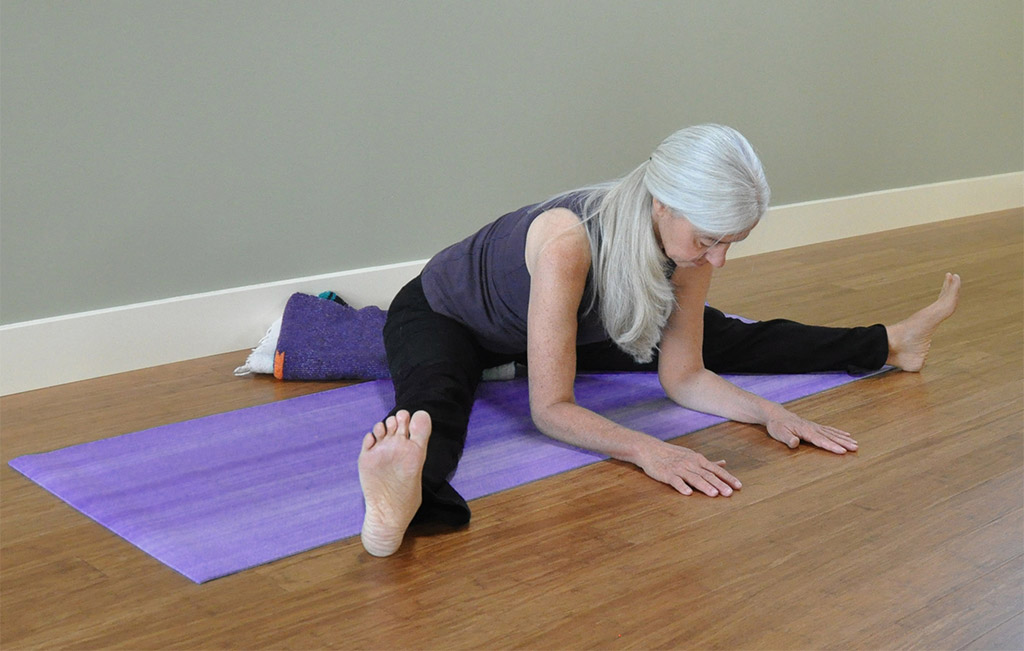
[ad_1]
This entry was posted on Jan 18, 2024 by Charlotte Bell.

Some years in the past, I led some yoga college students by means of a quite prolonged sequence of leg-stretching asanas based mostly on Supta Padanghustasana (Supine Large Toe Pose). At the moment, I had all the time ended the sequence with a one-legged model of Yoganidrasana (ankles behind the pinnacle). After all, most individuals in my courses really feel fairly versatile if their foot finally ends up inside a number of inches of their faces. And actually, that’s actually fairly versatile in comparison with the common individual on the road. Some may even suppose that’s a sign of being a complicated yogi.
The orientation and depth of many individuals’s hip sockets won’t ever enable an Instagram star expression of the pose. I’m one of many few individuals whose hip joints are amenable to Yoganidrasana, and to poses similar to Padmasana (Lotus Pose). I don’t take specific pleasure on this; it’s not one thing I earned by means of laborious work. It’s merely a genetic variation I inherited from my gymnast father.
Yoganidrasana and the SI Joint
The directions for shifting into Yoganidrasana might be complicated to college students, most likely as a result of the pose has nothing in widespread with on a regular basis motion. Once I demonstrated Yoganidrasana, it was for readability. It was, in reality, useful to display the model that most individuals can accomplish. This includes bending one knee towards the chest, inserting the ankle within the bend of the other elbow and drawing the leg in towards the chest. As I supplied the choice—considerably jokingly—of slipping the ankle behind the pinnacle, it occurred to me to do what I’ve usually finished: Reveal.
For per week previous to this class, I’d been combating sacroiliac (SI) ache and sciatica. I attribute this to my genetically free joints, together with years of training alignment directions that I later discovered to be inappropriate. As well as, youthful enthusiasm impressed me to attempt each “superior” pose I may drive myself into again within the Nineteen Eighties. In consequence, my SI joint has turn out to be fragile and unstable.
Trashing Your SI Joint Does Not Make Anybody an Superior Yogi
My SI joint is the proverbial canary within the coal mine for me. On one hand, it’s fairly helpful; it provides me rapid suggestions when my alignment is ever-so-slightly unhealthy. I’ve discovered volumes about wholesome SI-joint alignment from residing with this extraordinarily delicate and communicative joint. However, my SI joint misaligns simply and turns excruciatingly painful on the slightest provocation.
So this time, after I had the choice to display Yoganidrasana, I selected the prudent path and opted out. By opting out, I saved myself SI hassle. However extra vital, I walked my discuss. I’d by no means encourage a scholar to push previous SI and sciatica ache. The one motivation I can consider for sliding my foot behind my head could be to show that I may do it, to indicate my college students what an “superior yogi” I’m.
Why Class Ranges Don’t Work for Yoga
I’ve lengthy advocated for a unique definition of the “superior” yogi. Outlined class ranges (Degree 1, 2, 3 and 4) appear synthetic, limiting and inaccurate to me. Some individuals come to yoga with our bodies that may do nearly each pose on the primary day. For instance, some individuals can push up into Urdva Dhanurasana (Upward Bow) with straight arms (the requirement for getting into some Degree 3 courses) with no restrictions. However, a yogi with 30 years’ expertise might have been born with extra secure joints. Extra secure joints will usually not enable arms to be straight in Upward Bow. This individual wouldn’t have the ability to attend an “superior” class. These parameters don’t appear helpful to me.
What Is an Superior Yogi?
For me, a complicated yogi is one who has a two-way communication together with his/her physique—talking and listening. A sophisticated yogi has the expertise to know when he/she is simply too exhausted, injured or fragile to observe a selected pose. An skilled yogi is aware of that the diploma to which you’ll stretch, the variety of Chaturangas (yoga push-ups) you are able to do, the size of time you possibly can keep in Headstand, or having straight arms in Urdva Dhanurasana doesn’t matter within the grand scheme. A sophisticated yogi’s ego is in test sufficient to know that what your physique can or can’t do isn’t a measure of your dedication to yoga. The mature yoga practitioner is aware of that simply since you can do a selected pose doesn’t imply that you just ought to.
Donna Farhi teaches that superior yogis might select to decide out of doing probably the most “superior” variations of poses, quite than push themselves to the purpose of harm. Superior yogis are the individuals who know that yoga isn’t about efficiency, however about freedom from the necessity to carry out. I’ve to agree. My determination to decide out of Yoganidrasana tastes way more of freedom than wedging my ankle behind my head ever may.
About Charlotte Bell
Charlotte Bell found yoga in 1982 and started instructing in 1986. Charlotte is the creator of Conscious Yoga, Conscious Life: A Information for On a regular basis Follow and Yoga for Meditators, each printed by Rodmell Press. Her third e book is titled Hip-Wholesome Asana: The Yoga Practitioner’s Information to Defending the Hips and Avoiding SI Joint Ache (Shambhala Publications). She writes a month-to-month column for CATALYST Journal and serves as editor for Yoga U On-line. Charlotte is a founding board member for GreenTREE Yoga, a non-profit that brings yoga to underserved populations. A lifelong musician, Charlotte performs oboe and English horn within the Salt Lake Symphony and people sextet Pink Rock Rondo, whose DVD received two Emmy awards in 2010.
[ad_2]